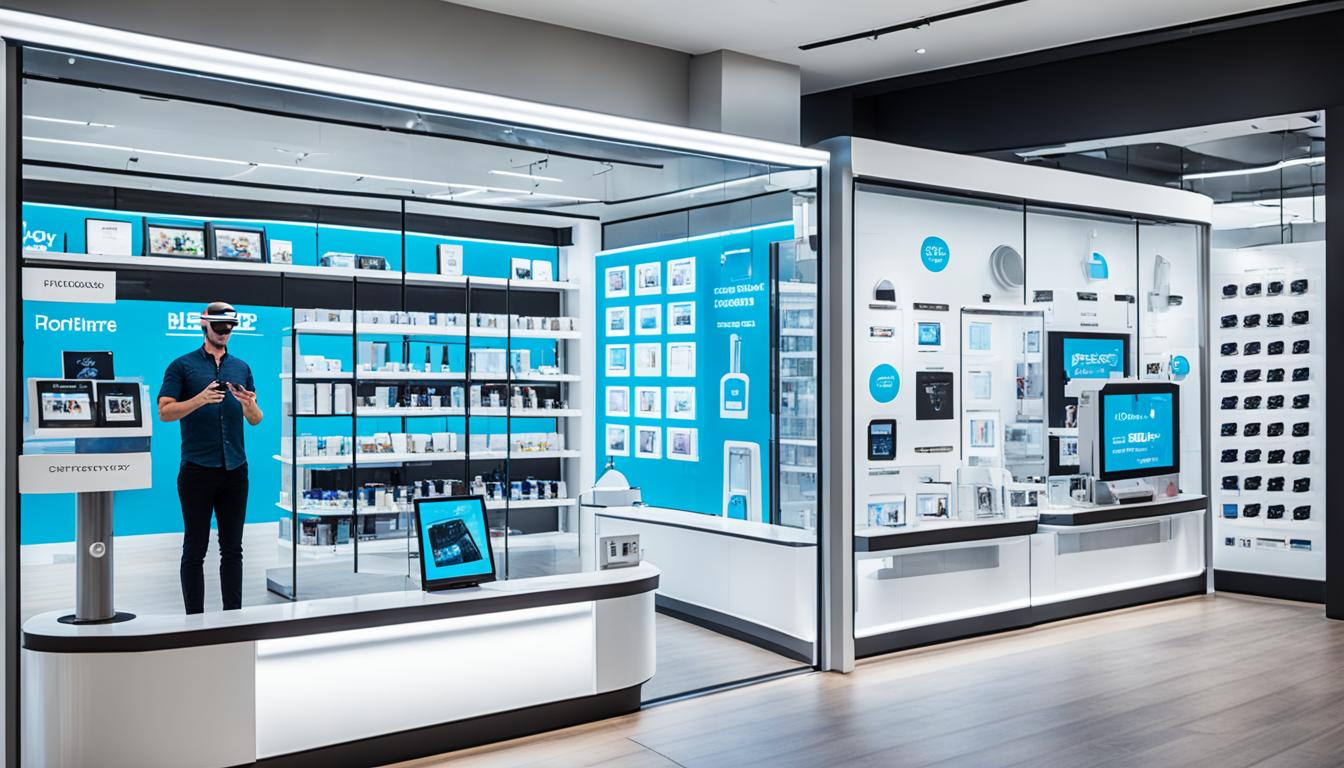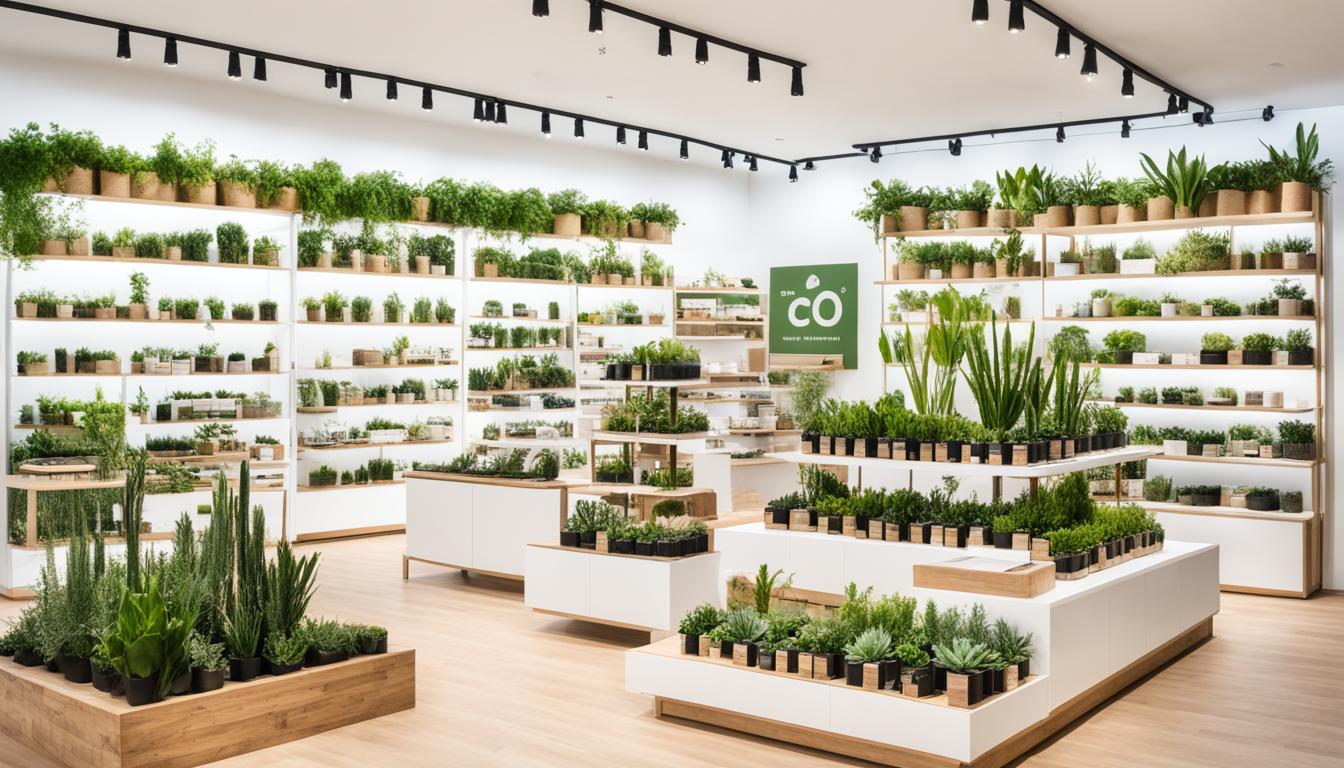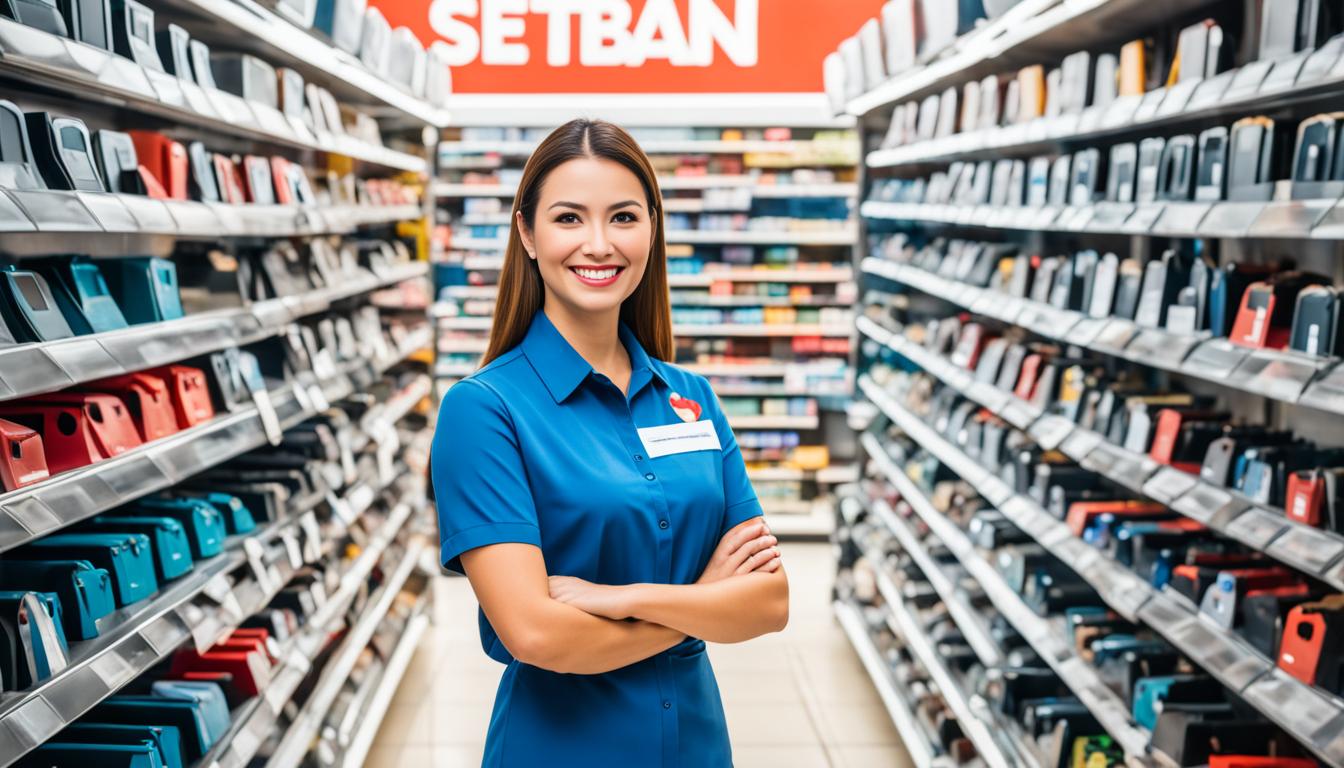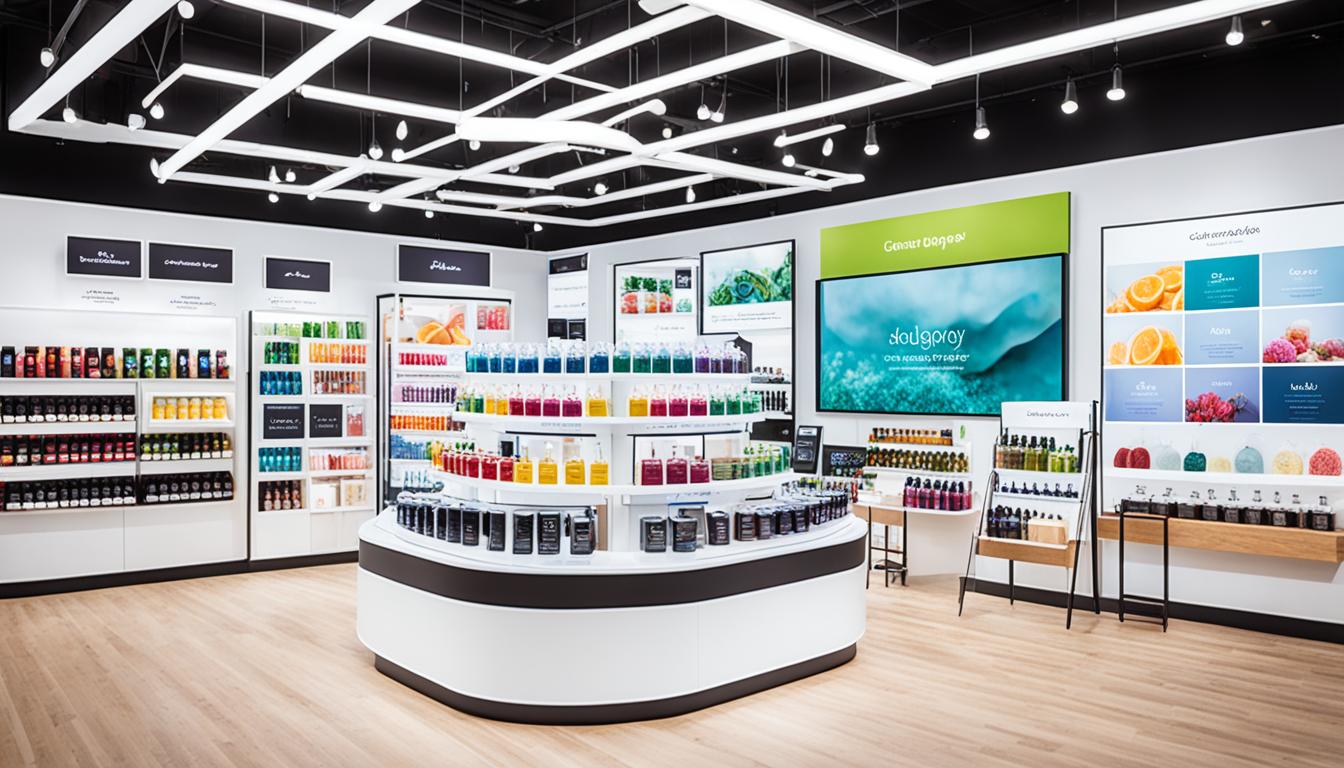The retail industry is constantly evolving, driven by changing consumer behavior and advancements in technology. To stay competitive and successful, it is important for retailers to stay ahead of the latest trends. In this article, we will explore the key trends that are shaping the future of retail and discuss their implications for businesses in the Philippines.
What does the future hold for the retail industry? Will technology completely transform the way we shop? Are brick-and-mortar stores still relevant in the digital age? Discover the answers to these questions and more as we delve into the trends that will define the future of retail.
Hybrid Retail Models Transforming Consumer Experience
The retail industry is undergoing a significant transformation as hybrid retail models emerge, blurring the lines between brick-and-mortar stores and e-commerce platforms. Retailers are recognizing the importance of integrating their physical stores with online platforms to create a seamless and enhanced shopping experience for consumers. This integration allows retailers to leverage the strengths of both offline and online channels, providing customers with convenience, choice, and personalized interactions.
One of the key advantages of hybrid retail models is the ability to offer omnichannel strategies that cater to the preferences of today’s consumers. With the increasing popularity of online shopping, retailers in the Philippines are keen on adopting omnichannel strategies to meet the evolving needs and expectations of their customers.
By combining the strengths of brick-and-mortar and e-commerce, retailers can provide a consistent and cohesive experience across all touchpoints. Whether it’s making a purchase in-store, browsing products online, or using click-and-collect services, customers can seamlessly transition between channels without any disruptions. This integration also allows retailers to offer features such as online inventory visibility, order tracking, and flexible fulfillment options, enhancing the overall consumer experience.
Additionally, hybrid retail models empower consumers with the ability to choose how they want to interact with retailers. Whether they prefer the in-person shopping experience or the convenience of online shopping, customers can engage with retailers in a way that suits their preferences and lifestyle. This flexibility and customization contribute to increased customer satisfaction and loyalty.
In summary, hybrid retail models are revolutionizing the retail landscape, allowing retailers in the Philippines to meet the changing needs and expectations of consumers. By seamlessly integrating brick-and-mortar stores with online platforms, retailers can create a cohesive and personalized shopping experience, resulting in enhanced customer satisfaction and business success.
Embracing Technology for Competitive Advantage
Technology is playing an increasingly critical role in shaping the future of retail. In order to stay ahead in a highly competitive market, retailers must embrace technological advancements to gain a competitive advantage. By integrating technology into their operations, retailers can enhance their efficiency, improve customer experiences, and streamline processes.
One of the ways that retailers in the Philippines are leveraging technology is through the use of AI-powered chatbots. These chatbots provide immediate customer support, answering inquiries and addressing concerns in a timely manner. The use of chatbots not only improves the speed of customer service but also allows retailers to allocate their human resources more effectively.
Advanced analytics is another technology that retailers are utilizing to gain a competitive edge. By analyzing vast amounts of data, retailers can gain insights into customer preferences, predict trends, and make informed business decisions. These insights enable retailers to tailor their offerings to meet the needs and desires of their target market, providing a more personalized shopping experience.
“Technology is not just a tool; it is a competitive advantage.”
Additionally, technology enables retailers to optimize their supply chain management, tracking inventory in real-time, and ensuring that products are available when and where customers need them. This improves operational efficiency and reduces the risk of stockouts, leading to better customer satisfaction and retention.
In conclusion, embracing technology is crucial for retailers in the Philippines to maintain a competitive advantage. By harnessing the power of AI, advanced analytics, and other technological solutions, retailers can enhance their operations, improve customer experiences, and stay ahead in an ever-evolving market.
Online Shopping: A Cornerstone of the Future of Retail
Online shopping has become an essential part of the retail landscape, especially in the wake of the COVID-19 pandemic. The growth of e-commerce is expected to continue as consumers increasingly prefer the convenience and safety of online shopping. Retailers in the Philippines need to adapt to changing consumer behavior in online shopping to stay relevant and competitive.
E-commerce Growth Post-Pandemic
The COVID-19 pandemic has accelerated the growth of e-commerce in the Philippines and around the world. With lockdowns and restrictions limiting physical shopping experiences, consumers turned to online platforms to fulfill their shopping needs. This surge in e-commerce has created new opportunities for retailers to expand their online presence and reach a wider customer base.
According to recent data, the e-commerce market in the Philippines is expected to reach an estimated value of $12.2 billion by 2025, indicating significant growth potential for retailers who tap into this market. With a young, tech-savvy population and increasing internet penetration, the Philippines presents a lucrative market for e-commerce businesses.
Adapting to Changing Consumer Behavior in Online Shopping
As consumer behavior continues to evolve, retailers need to stay updated with the latest trends and preferences in online shopping. There are several key areas that retailers should focus on:
- Mobile shopping: With the widespread use of smartphones, optimizing the mobile shopping experience is crucial. Retailers should ensure that their websites are mobile-friendly and provide a seamless browsing and purchasing experience on smaller screens.
- Personalization: Consumers expect personalized experiences when shopping online. Retailers should utilize data analytics and customer insights to tailor recommendations, promotions, and communications to individual shoppers.
- Omnichannel integration: Integrating online and offline channels is essential for retailers to provide a seamless shopping experience. This includes offering options such as click-and-collect, in-store pickup, and easy returns across all channels.
- Enhanced customer support: Online shoppers seek prompt and helpful customer support. Retailers should invest in chatbots, live chat features, and streamlined customer service processes to ensure a positive shopping experience.
By embracing these changes and adapting their strategies accordingly, retailers can successfully navigate the evolving landscape of online shopping and reap the benefits of continued e-commerce growth.
| Key Takeaways |
|---|
| Online shopping has become a vital component of the retail industry, driven by the convenience and safety it offers. |
| Post-pandemic, the e-commerce market in the Philippines is expected to witness significant growth, presenting opportunities for retailers. |
| To stay competitive, retailers must adapt to changing consumer behavior in online shopping, prioritizing mobile optimization, personalization, omnichannel integration, and enhanced customer support. |
Environmental Consciousness Shaping Retail Packaging
As consumers become more environmentally conscious, retailers are taking steps to align their packaging practices with sustainability. In response to the growing demand for eco-friendly options, retailers in the Philippines are adopting sustainable packaging solutions that prioritize environmental conservation and reduce waste.
Retailers are opting for recyclable or biodegradable materials to minimize their packaging footprint. By replacing traditional plastic packaging with biodegradable alternatives, such as compostable bags or plant-based materials, retailers are reducing their contribution to plastic waste and supporting a more sustainable future.
| Benefits of Sustainable Retail Packaging |
|---|
|
Sustainable packaging not only benefits the environment but also resonates with consumers who prioritize ethical and environmentally friendly practices. By adopting sustainable packaging solutions, retailers can strengthen their brand image, attract environmentally conscious consumers, and contribute to a more sustainable future.
Retail Workforce Management and Technology Integration
Hybrid Roles and Digital Recruitment
The integration of technology in retail workforce management is revolutionizing the way businesses operate. To stay competitive in today’s digital age, retailers are adopting hybrid roles that combine online and offline responsibilities. By leveraging technology and embracing digital recruitment strategies, retailers can attract top talent and meet the evolving needs of the industry.
Hybrid roles enable employees to adapt to the changing demands of the retail landscape. They involve a combination of traditional in-store tasks and digital responsibilities, such as managing online orders, coordinating deliveries, and providing virtual customer service. This integration allows retailers to provide a seamless experience to customers across multiple channels.
Digital recruitment has become increasingly important in the retail sector. Retailers are utilizing technology platforms and digital channels to attract and hire talent. This includes online job boards, social media platforms, and virtual interviews. By leveraging digital recruitment strategies, retailers can expand their talent pool and efficiently identify candidates who possess the necessary skills for hybrid roles.
Technological Solutions to Enhance Employee Experience
Technology is also being used to enhance the employee experience in the retail sector. Retailers are implementing technological solutions to streamline processes, improve productivity, and provide a more engaging work environment. For example, workforce management software enables efficient scheduling, task management, and performance tracking.
Additionally, retailers are leveraging mobile applications and communication tools to enhance employee communication and collaboration. These tools enable real-time communication, task delegation, and access to important information, improving overall efficiency and teamwork.
Moreover, technology integration offers opportunities for employee training and development. E-learning platforms and virtual training programs allow retailers to provide ongoing education and upskilling opportunities to their workforce, ensuring employees stay updated with the latest industry trends and technology advancements.
By harnessing the power of technology, retailers can enhance their workforce management practices, attract top talent, and create a positive employee experience. These technological advancements not only improve operational efficiency but also foster a culture of innovation and growth within the retail industry.
Customer Data Protection: A Priority for Retailers
The increasing reliance on customer data in retail operations has made protecting consumer data a top priority for retailers. With sensitive information at stake, it is crucial for businesses to adhere to consumer data privacy laws and implement robust cybersecurity measures.
Adhere to Consumer Data Privacy Laws
Retailers must comply with data privacy laws to ensure the protection of customer information. These laws dictate how customer data should be collected, stored, and used, providing guidelines for transparency, consent, and the secure handling of data. By strictly adhering to these privacy laws, retailers can establish trust with their customers and demonstrate their commitment to data protection.
Implications of Cybersecurity on Brand Reputation
Cybersecurity breaches can have severe consequences on a brand’s reputation. A data breach can lead to loss of customer trust, damage to brand reputation, and financial repercussions. Retailers need to prioritize cybersecurity by investing in robust security systems, conducting regular audits, and implementing strong security protocols. By doing so, they can protect their customers’ data, maintain brand trust, and safeguard their reputation.
| Data Protection Measures | Benefits |
|---|---|
| Encryption of customer data | Prevent unauthorized access and ensures data confidentiality |
| Regular security audits | Identify vulnerabilities and address potential risks |
| Strict access controls | Limit access to customer data to authorized personnel only |
| Implementing multi-factor authentication | Strengthen authentication processes and protect against unauthorized access |
| Employee training on data protection | Ensure staff are aware of data protection policies and best practices |
Implementing these data protection measures can help retailers mitigate the risk of data breaches and safeguard their customers’ information. By prioritizing customer data protection and complying with privacy laws, retailers can preserve brand reputation, build trust with customers, and enhance their overall cybersecurity posture.
Micro Fulfillment Centers: Rethinking Product Distribution
Micro fulfillment centers are revolutionizing product distribution in the retail industry. By establishing smaller fulfillment centers located closer to customers, retailers can improve efficiency and reduce delivery times. This new approach to product distribution is reshaping the way retailers meet the demands of an evolving e-commerce landscape.
Localized Supply Chain Solutions
In the Philippines, retailers are exploring localized supply chain solutions to optimize their operations. By decentralizing their distribution network and strategically locating fulfillment centers, retailers can minimize logistical challenges and reach their customers more efficiently. These localized supply chain solutions ensure that products can be sourced, stored, and dispatched swiftly, allowing for faster and more reliable delivery to customers.
Influence of E-commerce on Fulfillment Strategies
The rise of e-commerce has had a profound impact on fulfillment strategies. As online shopping continues to gain popularity, retailers need to adapt their fulfillment processes to meet the demands of the digital marketplace. Micro fulfillment centers enable retailers to process and fulfill online orders more efficiently, enhancing the overall customer experience. With faster delivery and improved inventory management, retailers can meet the expectations of today’s tech-savvy consumers.
| Benefits of Micro Fulfillment Centers: |
|---|
| Improved efficiency in product distribution |
| Reduced delivery times for customers |
| Enhanced inventory management |
| Faster processing and fulfillment of online orders |
| Optimized supply chain for e-commerce |
Enhancing In-Store Experiences to Compete with E-commerce
Brick-and-mortar retailers are facing increasing competition from the convenience of online shopping. To stay relevant and compete with e-commerce, businesses are focusing on enhancing in-store experiences. By creating unique and immersive shopping environments, retailers can attract customers who seek a personalized and engaging shopping journey.
One strategy is to create visually appealing displays and layouts that catch the attention of shoppers. By incorporating elements of experiential marketing, retailers can stimulate all the senses and create a memorable shopping experience. For example, using lighting techniques to highlight key products or implementing interactive displays that allow customers to engage with the merchandise.
In addition to aesthetics, personalization is key to enhancing in-store experiences. By analyzing customer data and preferences, retailers can tailor their offerings and recommendations, making the shopping journey more personalized and targeted to individual needs and preferences. Personalized recommendations and offers can be provided through digital signage, mobile apps, or with the assistance of knowledgeable sales associates.
Leveraging technology is another way to provide a seamless and engaging in-store experience. Retailers are incorporating self-checkout options, mobile payment systems, and interactive touchscreens to streamline the checkout process and make it more convenient for customers. Additionally, augmented reality (AR) and virtual reality (VR) technologies can be used to create interactive and immersive experiences, allowing customers to visualize products in real-time or virtually try them on.
By focusing on creating unique, personalized, and technologically advanced in-store experiences, retailers can differentiate themselves from e-commerce competitors and attract customers who value the tactile and sensory aspects of shopping. The future of brick-and-mortar retail lies in providing exceptional in-store experiences that go beyond the transactional, fostering a deeper connection between the brand and the customer.
The Surge of Personal Shopping Services and Automation
Utilizing Personal Shoppers for Enhanced Customer Service
The retail industry has witnessed a surge in personal shopping services, aiming to provide customers with personalized experiences and exceptional customer service. Retailers have recognized the value of catering to individual preferences and have employed personal shoppers to assist customers throughout their shopping journey. These personal shoppers offer expert guidance, tailored recommendations, and an extra level of personalized service to create a memorable shopping experience for customers.
Technology in Automated Pricing and Efficiency
In addition to personal shoppers, automation has become a critical component in the retail landscape. Retailers are leveraging technology to automate pricing strategies and enhance operational efficiency. Automated pricing tools analyze market trends, competitor prices, and customer demand to optimize pricing decisions in real-time. By automating the pricing process, retailers can streamline operations, reduce time-consuming manual tasks, and ensure dynamic pricing that aligns with market dynamics.
Furthermore, automation extends beyond pricing to various aspects of retail operations, such as inventory management, order fulfillment, and customer service. By implementing automated systems, retailers can improve accuracy, minimize errors, and enhance overall efficiency. Whether it’s utilizing chatbots for customer inquiries or implementing robotic systems for order fulfillment, automation plays a significant role in providing a seamless and efficient retail experience for customers.
Conclusion
The future of retail in the Philippines is at a critical juncture. Fostering innovation and preparing small and medium-sized enterprises (SMEs) for the evolving dynamics of the industry is more important than ever. As the retail landscape continues to undergo rapid transformation, retailers must embrace emerging trends, leverage technology, and adapt to changing consumer behavior in order to thrive.
Innovation is key to staying ahead in the Philippine retail landscape. By constantly exploring new ideas, implementing creative solutions, and challenging the status quo, retailers can unlock new opportunities for growth and success. Whether it’s through adopting cutting-edge technologies, reimagining store layouts, or developing unique marketing strategies, innovation will be the driving force for retailers in the years to come.
However, it’s not just the big players in the industry that need to adapt. SMEs also have a crucial role to play in the future of retail. By embracing innovation, investing in technology, and developing nimble business strategies, SMEs can compete on a level playing field with larger retailers. The evolving dynamics of the industry present both challenges and opportunities, and SMEs must be prepared to navigate these changes in order to thrive.
In conclusion, the future of retail in the Philippines is bright for those who are willing to embrace innovation and adapt to the evolving dynamics of the industry. By staying on top of emerging trends, leveraging technology, and fostering a customer-centric approach, retailers – big and small – can position themselves for success in the ever-changing retail landscape.
FAQ
What are the key trends shaping the future of retail?
The key trends shaping the future of retail include the integration of brick-and-mortar and e-commerce, the growth of omnichannel strategies, technology integration, the rise of online shopping, sustainable packaging practices, transformation in retail workforce management, customer data protection, micro fulfillment centers, enhancing in-store experiences, and the surge of personal shopping services and automation.
How are retailers integrating brick-and-mortar and e-commerce?
Retailers are integrating their physical stores with online platforms to provide a seamless shopping experience. This includes features like click-and-collect, in-store pickups for online orders, and the ability to return online purchases to physical stores.
What is the demand for omnichannel strategies in the Philippines?
In the Philippines, there is a growing demand for omnichannel strategies that cater to the preferences of both online and offline shoppers. Consumers expect a consistent and convenient experience across all touchpoints, whether it’s shopping in-store or online.
How does technology play a role in the future of retail?
Technology plays a crucial role in improving operations, enhancing customer experiences, and streamlining processes. Retailers are leveraging technologies like AI-powered chatbots, advanced analytics, and automation to gain a competitive advantage in the market.
What is the impact of online shopping on the retail industry?
Online shopping has become an essential part of the retail landscape, especially in the wake of the COVID-19 pandemic. The growth of e-commerce is expected to continue as consumers increasingly prefer the convenience and safety of online shopping.
How can retailers adapt to changing consumer behavior in online shopping?
Retailers in the Philippines need to adapt to changing consumer behavior in online shopping by investing in user-friendly websites, seamless checkout processes, secure payment methods, and fast and reliable delivery options.
How are retailers addressing sustainability in their packaging?
Retailers are adopting sustainable practices in their packaging, including the use of recyclable or biodegradable materials and reducing plastic waste. This is in line with the global movement towards more eco-friendly packaging solutions.
How is technology transforming retail workforce management?
Technology is transforming retail workforce management by enabling retailers to adopt hybrid roles that combine online and offline responsibilities. Digital recruitment strategies are also being used to attract top talent, and technological solutions are implemented to enhance the employee experience and improve productivity.
Why is protecting consumer data important for retailers?
Protecting consumer data is a top priority for retailers as failure to do so can lead to significant damage to a brand’s reputation and financial consequences. Retailers must adhere to consumer data privacy laws and implement robust cybersecurity measures to safeguard sensitive information.
How are micro fulfillment centers revolutionizing product distribution?
Micro fulfillment centers are smaller fulfillment centers located closer to customers. By establishing these centers, retailers can improve efficiency and reduce delivery times, meeting the demands of e-commerce and enhancing fulfillment strategies.
How are brick-and-mortar retailers enhancing in-store experiences?
Brick-and-mortar retailers are focusing on creating unique and immersive shopping environments, personalizing the customer journey, and leveraging technology to provide a seamless and engaging in-store experience. This includes features like interactive displays, augmented reality, and personalized recommendations.
How are personal shopping services and automation being used in retail?
Retailers are leveraging personal shoppers to provide enhanced customer service and personalized experiences. Additionally, technology is being used for automated pricing and efficiency, allowing retailers to optimize pricing strategies and streamline operations.
How can retailers thrive in the ever-changing retail landscape?
To thrive in the ever-changing retail landscape, retailers should foster innovation, embrace emerging trends, leverage technology, and adapt to changing consumer behavior. This also includes preparing small and medium-sized enterprises (SMEs) for the evolving dynamics of the industry.





